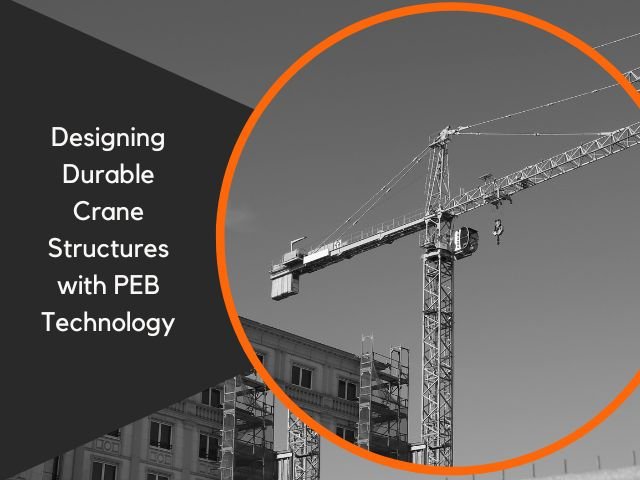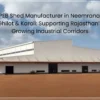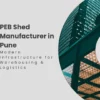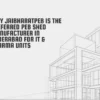Designing Durable Crane Structures with PEB Technology
Have you ever wondered how massive cranes lift tons of weight without collapsing under pressure? The secret lies in their structural design, and pre-engineered building (PEB) technology is transforming how we build these giants. From towering industrial cranes to aircraft hangars and PEB sheds, PEB systems offer unmatched durability, flexibility, and cost savings. In this guide, we’ll dive into why designing durable crane structures with PEB technology is a game-changer, blending engineering precision with practical innovation.
Whether you’re a contractor, engineer, or business owner, understanding PEB technology can help you build stronger, more efficient structures. Let’s explore how this modern approach delivers crane structures that stand the test of time, with a focus on applications like aircraft hangars and PEB sheds.
What Is PEB Technology?
Pre-engineered building (PEB) technology involves designing and fabricating building components in a factory before assembling them on-site. Unlike traditional construction, PEB systems use standardized, pre-fabricated steel components tailored to specific project needs. This method reduces waste, speeds up construction, and ensures consistent quality.
For crane structures, PEB technology is a perfect fit. Cranes require robust frameworks to handle heavy loads, and PEB’s precision-engineered steel beams and columns provide the strength needed. By designing durable crane structures with PEB technology, engineers can create systems that support dynamic loads while maintaining structural integrity.
- Key Benefits of PEB:
- Faster construction timelines (up to 50% quicker than traditional methods).
- Cost savings due to reduced material waste and labor.
- High durability with corrosion-resistant steel.
- Customizable designs for unique applications like aircraft hangars and PEB sheds.
Why Choose PEB for Crane Structures?
Cranes operate under intense stress, lifting thousands of pounds daily. A poorly designed structure can lead to catastrophic failures. PEB technology addresses this by offering:
- Strength and Stability: PEB components are designed using advanced software to withstand heavy loads and environmental factors like wind or seismic activity.
- Flexibility: Need a crane structure for an aircraft hangar? PEB systems allow for wide clear spans, perfect for large spaces without obstructive columns.
- Cost-Effectiveness: According to industry data, PEB structures can reduce construction costs by 20–30% compared to conventional steel buildings.
For example, a 2023 case study of an aircraft hangar in Texas showed that using PEB technology cut construction time by 40% and saved $200,000 in material costs. This makes PEB ideal for designing durable crane structures with PEB technology.
How PEB Enhances Crane Structure Durability
Durability is non-negotiable for crane structures. PEB technology ensures long-lasting performance through:
- High-Quality Materials: PEB systems use high-strength steel (typically 350 MPa yield strength) coated with corrosion-resistant finishes like galvanization.
- Precision Engineering: Components are manufactured to exact specifications, reducing weak points.
- Load-Bearing Capacity: PEB designs account for dynamic crane loads, ensuring stability during heavy lifts.
For instance, PEB sheds used in industrial settings often incorporate crane runways designed to handle repetitive stress without deformation. This durability extends the lifespan of the structure, reducing maintenance costs.
Designing for Heavy Loads in Crane Structures
Cranes lift massive weights, so their supporting structures must be engineered for extreme loads. PEB technology excels here by:
- Optimizing Load Distribution: PEB systems use tapered columns and rigid frames to evenly distribute weight, minimizing stress concentration.
- Supporting Dynamic Loads: Crane movements create vibrations, but PEB’s bolted connections absorb and dissipate these forces.
- Customizable Runways: PEB crane runways can be tailored for specific crane types, such as overhead or gantry cranes.
A real-world example is a PEB shed in a manufacturing plant that supported a 50-ton overhead crane. The structure’s design allowed for seamless operation over a 100-foot span, proving PEB’s capability for heavy-duty applications.
PEB Technology in Aircraft Hangars
Aircraft hangars require vast, open spaces to accommodate planes, making them a prime candidate for PEB technology. Designing durable crane structures with PEB technology for aircraft hangars offers:
- Wide Clear Spans: PEB systems can create spans up to 100 meters without interior columns, ideal for housing aircraft.
- Quick Assembly: Prefabricated components mean hangars can be operational in months, not years.
- Durability: PEB hangars withstand harsh weather, protecting valuable assets like planes and cranes.
For example, a 2024 project in Florida used PEB technology to build an aircraft hangar with an integrated crane system, completed 30% faster than traditional methods.
PEB Sheds for Industrial Crane Applications
PEB sheds are another excellent application for crane structures. These sheds are often used in warehouses, factories, and logistics hubs where cranes operate daily. Here’s why PEB sheds shine:
- Scalability: PEB sheds can be expanded easily, accommodating growing operational needs.
- Cost Efficiency: Lower material and labor costs make PEB sheds budget-friendly.
- Crane Integration: PEB sheds can incorporate overhead crane systems with minimal modifications.
A logistics company in India reported that their PEB shed, designed for a 20-ton crane, reduced construction costs by 25% compared to a conventional steel structure.
How to Design a PEB Crane Structure: Step-by-Step
Designing durable crane structures with PEB technology follows a streamlined process:
- Assess Load Requirements: Calculate the crane’s maximum load and dynamic forces.
- Choose Materials: Select high-strength steel with appropriate coatings for the environment.
- Use Design Software: Tools like STAAD.Pro or Tekla ensure precise structural analysis.
- Fabricate Components: Manufacture beams, columns, and connections in a controlled factory setting.
- Assemble On-Site: Bolt components together for quick, secure construction.
- Test and Commission: Verify the structure’s stability under load before full operation.
This process ensures safety and efficiency, especially for applications like aircraft hangars and PEB sheds.
Common Challenges and Solutions in PEB Crane Design
Even with PEB’s advantages, challenges can arise. Here’s how to address them:
- Challenge: Misaligned crane runways.
- Solution: Use laser-guided alignment during installation to ensure precision.
- Challenge: Corrosion in humid environments.
- Solution: Apply advanced coatings like epoxy or polyurethane to steel components.
- Challenge: Overloading due to miscalculated crane loads.
- Solution: Conduct thorough load analysis with safety margins of at least 25%.
These solutions ensure that designing durable crane structures with PEB technology remains reliable and safe.
Environmental Benefits of PEB Crane Structures
PEB technology isn’t just strong—it’s sustainable. Here’s how:
- Reduced Material Waste: Factory-controlled fabrication minimizes excess materials.
- Energy Efficiency: PEB structures can incorporate insulation for climate control, reducing energy costs.
- Recyclability: Steel components are 100% recyclable, supporting eco-friendly construction.
A 2022 study found that PEB construction reduced carbon emissions by 15% compared to traditional methods, making it a green choice for crane structures.
Cost Comparison: PEB vs. Traditional Construction
When designing durable crane structures with PEB technology, cost is a major factor. Here’s a breakdown:
| Aspect | PEB Technology | Traditional Construction |
|---|---|---|
| Construction Time | 3–6 months | 6–12 months |
| Material Costs | 20–30% lower | Higher due to waste |
| Labor Costs | Reduced (pre-fab) | Higher (on-site work) |
| Maintenance | Low (durable coatings) | Higher (more upkeep) |
This comparison highlights why PEB is ideal for projects like aircraft hangars and PEB sheds.
Designing Durable Crane Structures with PEB Technology – Frequently Asked Questions
What is PEB technology in crane structure design?
PEB technology uses pre-fabricated steel components to build strong, efficient crane structures. It’s ideal for applications like aircraft hangars and PEB sheds due to its speed and durability.
How does PEB improve crane structure durability?
PEB systems use high-strength steel and precise engineering to handle heavy loads and resist corrosion, ensuring long-lasting performance. Learn more about durability factors.
Can PEB be used for aircraft hangars?
Yes, PEB is perfect for aircraft hangars, offering wide clear spans and quick assembly. See how it’s applied in aircraft hangar design.
What are the cost benefits of PEB crane structures?
PEB reduces construction costs by 20–30% through efficient material use and faster assembly. Check the cost comparison for details.
Are PEB crane structures environmentally friendly?
Yes, PEB minimizes waste and uses recyclable steel, reducing environmental impact. Explore the environmental benefits for more insights.
How long does it take to build a PEB crane structure?
PEB structures can be completed in 3–6 months, significantly faster than traditional methods. See the design process for a breakdown.
What challenges arise in PEB crane design?
Common challenges include runway misalignment and corrosion, but these can be addressed with precise installation and coatings. Learn more in the challenges section.
Conclusion
Designing durable crane structures with PEB technology offers a powerful combination of strength, efficiency, and sustainability. From aircraft hangars and PEB sheds to heavy-duty industrial applications, PEB systems deliver reliable performance at a lower cost. By leveraging precision engineering and high-quality materials, you can build crane structures that withstand the toughest conditions while saving time and money. Have you used PEB technology in your projects? Share your experience or explore our related guides on industrial construction trends or sustainable building solutions.






